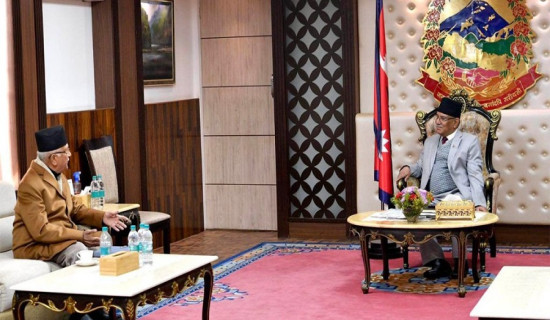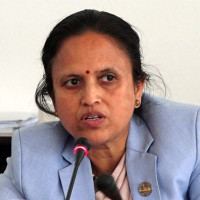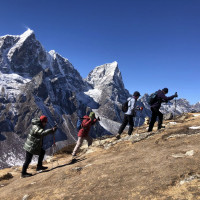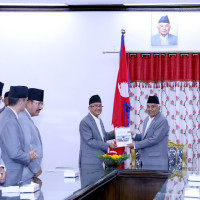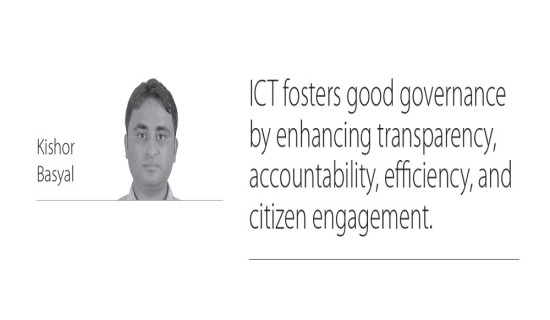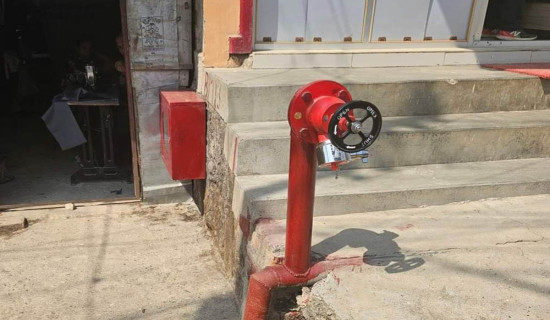- Thursday, 2 May 2024
“We are dedicated to improve livelihood of people”
The former village development committees of Chang, Jamune, and Manpang now belong to the Myagde Rural Municipality in Tanahun. The area is divided into seven wards and shares borders with Beyas, Bhimad, Shuklagandaki, and Rishing municipalities. Most wards are accessible by road, thanks to the Prithbi Highway. The municipality, mainly inhabited by the Magars, is renowned for its natural beauty and is famous for orange and potato cultivation.
Shri Prasad Shrestha, representing CPN-UML, is the elected chairman of the rural municipality. Our Tanahun correspondent Amar Raj Naharki interviewed him regarding issues of local development and service delivery.
What are the major activities accomplished so far in the current fiscal year?
In the current fiscal year, so far, four laws and 11 procedures have been formulated. Altogether, 15 villages and eight executive meetings of the rural municipality have been held. The assembly has made 28 decisions with four laws, while the executive committee has made 184 decisions through 11 meetings. Annual budget books and annual progress report books have been printed and distributed to 400 offices, including officers, branch heads, ward offices, tole development institutions, schools, and all stakeholders.
Likewise, 39 officers and 31 employees, along with branch heads, participated in a two-day orientation programme on the federal affairs and general administration, organised in collaboration with the Ministry of Federal Affairs and Local Development and the Local Development Training Institute. The programme covered planning, budgeting, service flow, technical and administrative aspects, as well as health and yoga-related information, contributing to improved service delivery. Orientation sessions were conducted for all consumer committee members in the ward for institutional capacity and financial risk assessment. Four community schools received 40 per cent grant assistance for school buses, while ambulance services were provided free of charge to beneficiaries, including a Rs. 5,000 regular grant under the chairman's programme.
Farmers raising calves received Rs. 10,000 per head encouragement and agricultural machinery was distributed with a 50 per cent grant. Milk producers received Rs. 10 per litre subsidy. Free kidney testing, breast cancer screening, and eye camps were held in two phases to facilitate additional treatment coordination for patients. Efforts have begun to approve local labour for villagers seeking foreign employment.
What are the plans to achieve prosperity with good governance?
Based on various indicators, including service delivery, financial status, and transparency, evaluations have been conducted according to the Local Governance Operation Directive 2021, the Financial Governance Risk Assessment Directive 2021, and the Local Economic Development Evaluation Directive 2023.
The rural municipality has achieved a score of 94.5 in the Local Level Institutional Capacity Assessment, becoming the first municipality in Gandaki Province, and has also ranked first among 10 municipalities in Tanahun District with a score of 81 in Financial Governance Risk Assessment. In this regard, our rural municipality is highly conscious of governance and transparency. We aim to address current weaknesses and strive towards minimising such issues to progress further.
What work has been done for the benefit of marginalised communities in the rural municipality?
Efforts have been made to uplift economically and socially marginalised groups by organising various types of skill development programmes to make them self-reliant. Funding has been provided in various sectors to promote entrepreneurship and create employment opportunities for them.
What are the plans to make the municipality prosperous?
As per the rights provided by the Constitution of Nepal 2015, having been elected to the position of Chairperson of the rural municipality, I have perceived the opportunity to serve the people that has been on my mind for a long time. To further develop and prosper the rural municipality, we are coordinating with knowledgeable intellectuals and stakeholders from all walks of life to gather feedback and suggestions, and to identify various development priorities.
What has been done for the education and health sectors?
The rural municipality has developed local curricula for classes up to grade five to provide students with practical knowledge of their local context. To address the difficulties faced by students in commuting to school, the rural municipality has provided 40 per cent funding for school buses to four schools, namely Minna Higher Secondary School, Mahendra Higher Secondary School, Radha Higher Secondary School, and Janatapati Higher Secondary School. In the health sector, regular health camps are being conducted, and recently, in collaboration with the Health Care Foundation Nepal, Surya Nepal, and the rural municipality, free kidney testing camps have been organised. In a joint initiative with the Tulsimaya Memorial Cancer Relief Foundation, free breast cancer screening camps and awareness programmes have been conducted for women, with recommendations for further treatment for identified patients. As per the shared goals of the rural municipality, a policy has been developed to provide free access to education and health services, and plans for future activities have been prepared accordingly, with a strong emphasis on these areas.
Is there encouragement available for farmers or not?
With the main slogan “Clean, Civilized, Prosperous Myagde”, the rural municipality has prioritised agriculture based on the indicators of development and is moving forward. Although the rural municipality has geographical diversity, it has a great potential for agriculture. While orange is the main topic of discussion in this region, other crops are also suitable. Due to favourable weather conditions, crops such as rice, maize, potatoes, and other crops can be cultivated in large volume, which has led to an increasing number of farmers taking up agriculture as an occupation in this area.
After providing training in beekeeping, 50 per cent of investment, including bee hives, is distributed, farmers are provided a subsidy of Rs. 10 per litre of milk, and those engaged in oxen farming are provided incentives of Rs. 10,000. Distribution of improved seeds to commercial farmers is done through official registration, along with 80 per cent subsidy on agricultural machinery. Due to the increase in income in the agricultural sector, farmers are becoming self-reliant day by day, and the message has been sent that even other villagers can sustain their livelihood by engaging in agriculture in their own areas.
Finally, what would you like to say?
The message is clear. The rural municipality is rapidly advancing towards development, ensuring full protection of the rights, interests, and entitlements of the villagers. With a commitment to improving the living standards of the people and discouraging illegal activities, efforts are being made to increase internal sources of revenue through various skill-oriented training programmes, aiming to make the community self-reliant. I express my dedication to impactful plans and programmes with action for the betterment of the community.
How did you feel after reading this news?



